Bathroom Readers' Institute's Blog, page 134
July 10, 2014
Impossible Questions: A Whale of a Tale! (The Answer)
Think you’ve got the answer? Keep reading to see if you nailed it.
What do Burger King and the NHL have in common…or at least, what did they once have in common?
This might be one of the strangest “Impossible Questions” we’ve ever done—or least the one that’s the biggest stretch. But when compiling articles for our latest Bathroom Reader a couple weeks ago, one of our writers noticed “Hartford Whalers” on a piece about defunct sports teams…and also noticed “Whaler” on a list of failed fast food items. “Whaler” isn’t a very common word outside of 19th century industrial circles, or 19th century English novels, so we thought it was interesting enough to take a look behind two unrelated, forgotten things, both named Whaler.
Similar to how the American Basketball Association tried to compete with the NBA for the attention of sports fans, the World Hockey Association was a 1970s attempt to unseat the NHL as the predominant professional hockey league. Twelve teams, mostly from cities with big hockey fanbases but no NHL team, began play in 1972, including the Winnipeg Jets, Quebec Nordiques, and New England Whalers. After playing two years in Boston (including a WHA championship in 1973), the team moved a short 100 miles to Hartford, Connecticut. When the WHA folded in 1979, the Whalers were absorbed by the NHL and changed its named to the Hartford Whalers. In the NHL, the Whalers were a perpetual cellar-dweller, rarely making the playoffs and making it to the conference finals just once. In 1997, the Whalers moved to Raleigh, North Carolina, and became the Carolina Hurricanes.
McDonald’s unveiled the Filet-O-Fish, first fast food fried fish sandwich in 1962 in order to please Cincinnati’s large Catholic population, who abstained from eating meat on Fridays. Burger King responded with the Whaler a few years later, introducing it in cities with big Catholic populations before making it a chain-wide offering by 1975. (The Whaler consisted of a fried fish patty on a bun with tartar sauce and lettuce.) Perhaps of an unappetizing name that makes customers think of whales, the Whaler was never widely popular, leading Burger King to reformulate and rename its fish sandwich every few years. Other names include the Ocean Catch, Big Fish, and Premium Alaskan Fish Sandwich.
Need more impossible questions? Check out Uncle John’s Impossible Questions.
The post Impossible Questions: A Whale of a Tale! (The Answer) appeared first on .
July 9, 2014
These Records Are Crazy
While CD sales continue to plunge, the sales of old-fashioned vinyl records have actually risen in the past few years. Why? Records offer a certain warmth, magic…and weirdness. Here’s a look at some of the kookiest wax in Uncle John’s collection.
“Warsaw in the Summer”
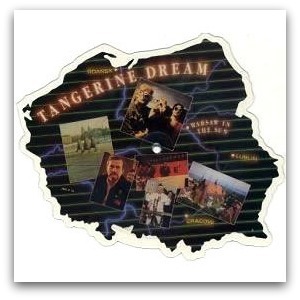 German band Tangerine Dream is best known for its dreamy electronic music but, in 1983, they released a 45 called “Warsaw in the Summer” that was shaped like Poland. While it’s one of the more unique vinyl records ever released, it’s not the only one shaped like something other than a circle. Other bands have cut records that resemble triangles, playing cards and even saw blades. This didn’t work out so well for They Might Be Giants member John Linnell’s 1999 single “Montana.” It was shaped like the United States…and didn’t work on most record players.
German band Tangerine Dream is best known for its dreamy electronic music but, in 1983, they released a 45 called “Warsaw in the Summer” that was shaped like Poland. While it’s one of the more unique vinyl records ever released, it’s not the only one shaped like something other than a circle. Other bands have cut records that resemble triangles, playing cards and even saw blades. This didn’t work out so well for They Might Be Giants member John Linnell’s 1999 single “Montana.” It was shaped like the United States…and didn’t work on most record players.
Laura Scudder’s “Magic Record”
Scudder was a California entrepreneur who created a popular brand of potato chips. She died in 1959, but a decade later her company released a “magic record” as a promotion. Both sides contained three songs by various artists that would play at random, depending on where the listener dropped the needle. The cover featured a cartoon character whispering: “Psssst! Hey Kids! What Will Play Next? Only the Needle Knows!” Records like this are typically referred to as “multi-sided records.” The oldest known one dates back to 1901, but acts like Kate Bush and Fine Young Cannibals have released their own versions more relatively recently.
Lazaretto
Who’s the bestselling artist on vinyl in the last decade? Jack White. The indie rock icon and former White Stripes front man just released his latest album, Lazaretto, and the vinyl version could be the strangest record of all time. It includes a reverse groove on side A that requires the listener to place the needle on the inside of the record as opposed to the outside edge. The first song on side B has two different intros, one acoustic and one electric; which one plays depends on where the listener places the needle. Along with songs hidden under the labels on both sides, the record also features two holograms of spinning angels. These illusions can be seen in the “dead vinyl” area o
The post These Records Are Crazy appeared first on .
July 7, 2014
Ask Uncle John Anything: Pop-Pop
Uncle John knows pretty much everything—and if he doesn’t, he heads his massive research library, or puts one of his many associates on the case. So go ahead: In the comments below, ask Uncle John anything. (And if we answer your question sometime, we’ll send you a free book!) This week’s question comes from reader Kristen G., who asks…
How did popcorn come to be the quintessential movie snack?
 Corn has long been an important crop to native peoples in the Western Hemisphere. Popcorn as we know it came via Central and South America by way of whalers. Historians think that New England whaling ships traveled to Chile and brought back different corn varieties, including the one whose kernels amusingly exploded when heated. By the middle of the 19th century, popcorn was hugely popular as a snack at public entertainments across the U.S.—it was cheap, easy to prepare (just add heat), and fun to eat. Popcorn vendors were soon ubiquitous at circuses and fairs.
Corn has long been an important crop to native peoples in the Western Hemisphere. Popcorn as we know it came via Central and South America by way of whalers. Historians think that New England whaling ships traveled to Chile and brought back different corn varieties, including the one whose kernels amusingly exploded when heated. By the middle of the 19th century, popcorn was hugely popular as a snack at public entertainments across the U.S.—it was cheap, easy to prepare (just add heat), and fun to eat. Popcorn vendors were soon ubiquitous at circuses and fairs.
It wasn’t always a popular movie snack—like during the silent film era. Movie exhibitioners didn’t sell popcorn (or any snacks) for silent films, believing that the sound of people eating, slurping, and snacking—especially crunchy, noisy, popcorn—would be distracting and off-putting. When the “talkie” arrived, so, too did popcorn…but not from the theater itself. In the 1930s, street vendors paid to park their carts outside of a movie theater or in the lobby and sell their wares. Average cost: about five cents a bag.
Candy remained the most popular movie treat up until World War II, before popcorn took its place. The major reason: candy bar production in the U.S. went way down due to the war-caused shortage of labor and the war-caused rationing of sugar. Popcorn remained a cheaper and more viable offering. It was also remarkably profitable for the theaters, who by mid-century ran their own concession stands. A 100-pound bag of kernels might cost $10 in 1945…and make a few thousand bags.
Now, don’t ask us how they make that weird, butter-flavored stuff they put on the popcorn. Nobody knows what that stuff is.
The post Ask Uncle John Anything: Pop-Pop appeared first on Uncle Johns Bathroom Reader.
July 3, 2014
An Expatriate Fourth of July
Just because you’re an American and you’re not in America doesn’t mean you can’t celebrate America’s Independence Day.
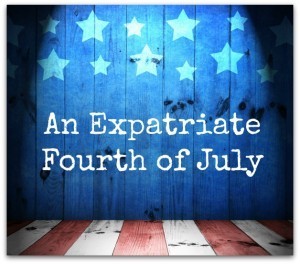 July 4th marks American independence, as well as independence for the Philippines…from the U.S.A. On July 4, 1946, the American government formally recognized the Philippines as an independent nation, ending 50 years of territorial rule. As a show of goodwill, July 4th was established as Filipino-American Friendship Day in the Philippines, recognizing both country’s “birthdays.”
July 4th marks American independence, as well as independence for the Philippines…from the U.S.A. On July 4, 1946, the American government formally recognized the Philippines as an independent nation, ending 50 years of territorial rule. As a show of goodwill, July 4th was established as Filipino-American Friendship Day in the Philippines, recognizing both country’s “birthdays.”12th Gate is an events planning company in Argentina started by four guys from Georgia. Their signature event for the past few years has been a Fourth of July-themed pub crawl. They’ve signed up several bars in Buenos Aires to offer hamburgers, hot dogs, red-white-and-blue Jell-O, a miniature American flag, some sparklers, and the most American innovation of all—a commemorative T-shirt—all for one ticket price.
Stubb’s Bar-B-Q is a Texas-based barbecue chain trying to franchise in China, while also introducing China to barbecue. Each year, it draws increasingly large crowds to an America-themed party on the Fourth of July. Employees pass out miniature American flags, line dancing contests are held, Budweiser is sold, and, of course, fireworks are set off (the majority of which are made in China).
The American Society of Sydney, Australia holds a massive, outdoor party, usually on or near Sydney Harbor. It draws more than 1,000 people, and admission is free if patrons “dress American” (whatever that means).
In 1912, Danish-Americans bought 200 acres in Rebild, Denmark, specifically to have a place to celebrate America’s Independence Day in their ancestral homeland. They donated it to the country, and it became Denmark’s first national park. It became the site of the largest American-style Fourth of July party (barbecue, fireworks) outside of the U.S., drawing more than 50,000 annual guests to four days of events.
The post An Expatriate Fourth of July appeared first on Uncle Johns Bathroom Reader.
These Places are Literally the Pits
You could book a vacation in Maui or head to Disney World and still wind up in a hotel that’s a total pit. Why settle for that when you can just visit a real pit instead?
The Mirny Diamond Mine
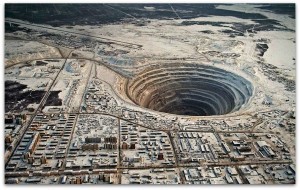 By one account, around 25% of all the world’s diamonds come from this mine just outside of Mirny, Russia. The drills began humming in the ‘50s and, since then, a colossal quarry has resulted. From the air, the pit, which is 1,722 feet deep and roughly three-quarters of a mile in diameter, looks like it was created by a Godzilla-sized mole determined to destroy the city. These days, the digging rarely stops and the mine operates around the clock seven days a week. Despite being located on the edge of an immense pit, over 37,000 people still call the town of Mirny home.
By one account, around 25% of all the world’s diamonds come from this mine just outside of Mirny, Russia. The drills began humming in the ‘50s and, since then, a colossal quarry has resulted. From the air, the pit, which is 1,722 feet deep and roughly three-quarters of a mile in diameter, looks like it was created by a Godzilla-sized mole determined to destroy the city. These days, the digging rarely stops and the mine operates around the clock seven days a week. Despite being located on the edge of an immense pit, over 37,000 people still call the town of Mirny home.
The Darvaza Gas Crater
The locals have a variety of colorful nicknames for this nightmarish pit in Turkmenistan’s Karakum Desert: “Derweze,” “The Gates of Hell,” and “The Door to Hell.” While it certainly looks like a sand trap on a hellish golf course, the crater attracts hundreds of tourists annually…and the occasional unlucky animal. Visitors say that spiders are especially drawn to its hypnotic flames. It all started in 1971, when Soviet geologists looking for oil in the region accidentally created the 230 foot pit after a drilling rig collapsed. To prevent the natural gas inside from creating a major safety hazard, they attempted to burn it all off. They figured that would take a few weeks, tops. Over 40 years later, the blaze is still going strong.
The Berkeley Pit
This former copper mine in Butte, Montana, opened in 1955 and was in continuous operation until its somewhat ironic closure on Earth Day 1982. When the drilling stopped, so did the mine’s pumps. As a result, tons of toxic water filled its quarry and the Berkeley Pit was born. In the ‘90s, roughly 5,000 gallons of the stuff was still flowing into the pit every single minute. In 1995, a large flock of geese made the tragic mistake of seeking shelter from inclement weather inside it. They wound up stuck down there after heavy fogs rolled in. Once it cleared, 342 of the birds were found dead. Nowadays, workers use loudspeakers and firecrackers to prevent a similar accident from happening. Despite being extremely polluted with over 40 billion gallons of acidic water (and some resultant freaky microscopic lifeforms), the pit is a tourist attraction that draws thousands of visitors every year. There’s even a Berkley Pit gift shop.
The post These Places are Literally the Pits appeared first on Uncle Johns Bathroom Reader.
July 2, 2014
The Weirdest Museum in New York City
If you’re heading to the Big Apple this summer, check out this odd attraction.
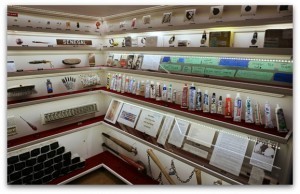 For the past few years, the Mmuseumm has offered visitors a glimpse at some truly weird wonders. The tiny museum is housed at the bottom of an old elevator shaft and can be found down a back alley in Manhattan’s Tribeca neighborhood. The interior is about 80 square feet and only three visitors can be inside at a time.
For the past few years, the Mmuseumm has offered visitors a glimpse at some truly weird wonders. The tiny museum is housed at the bottom of an old elevator shaft and can be found down a back alley in Manhattan’s Tribeca neighborhood. The interior is about 80 square feet and only three visitors can be inside at a time.
The curios on display rotate seasonally but there are a few permanent exhibitions. One includes a leather shoe that was supposedly thrown at former president George W. Bush during a press conference in 2008. (The museum’s curators will neither confirm, nor deny, its authenticity.)
If that doesn’t float your boat, the Mmuseumm’s current displays feature plastic spoons, various artifacts from North Korea, and what the curators call “Censored Saudi Arabian Pool Toys.” There’s also a collection of 200 mosquitoes from New Delhi that were supposedly caught and killed while attacking their victims.
The kooky museum was created by Red Bucket Films, a small studio that specializes in artistic projects and eclectic documentaries. When their landlord began renovating their building, he asked the studio if they’d like to use part of the defunct elevator shaft near their office for storage. When they asked him if they could turn it into a small museum instead, the landlord agreed.
The Mmuesumm’s grand opening in 2012 featured a Rudy Giuliani impersonator and a few jam bands. Back then, its collection included photos from old Cambodian menus, rusty combs and paper from copy machines. While those items might not sound too terribly exciting, the museum’s quirkiness attracted tons of visitors and national press attention.
While its New York City’s smallest museum, that doesn’t mean it doesn’t contain a cafe and a gift shop. However, the “cafe” is really just a cappuccino machine mounted on a wall. The gift shop, meanwhile, consists of a few postcards and pencils on a shelf over the cappuccino machine. There’s even an audio guide that can be accessed by dialing a toll-free number.
If you’re interested in visiting the Mmuseumm, it’s only open on the weekends from noon to 6 p.m. Admission is free but donations are accepted.
The post The Weirdest Museum in New York City appeared first on Uncle Johns Bathroom Reader.
Killer Commodes: 4 Fictional Characters Who Died On the Toilet
Elvis passed away on a potty 37 years ago this summer. Since then, many fictional heroes and villains have shuffled off this mortal coil in a similar fashion. (WARNING: Don’t read this post if you don’t want to have the season finale of a certain HBO fantasy series spoiled.)
Vincent Vega
Director Quentin Tarantino provided John Travolta with one of his many career comebacks (and a Best Actor nomination at the Oscars) in 1994 with Pulp Fiction. In the film, several characters run into trouble while visiting restrooms, but only Vincent Vega (Travolta) doesn’t survive his pit stop. Vega is slaughtered while exiting a bathroom (where he was also reading, we’re happy to add) after absentmindedly leaving his gun on a kitchen counter.
Philip Hardin
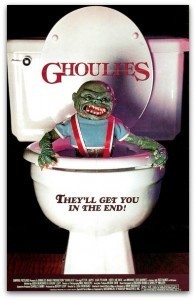 The four Ghoulies films from the ‘80s and ‘90s are considered knockoffs of the far more successful Gremlins franchise. While they’re mostly forgotten now, lots of people remember the first film’s poster, which features a nasty monster popping out of a toilet and the clever tagline, “They’ll Get You in the End!” Originally, Ghoulies didn’t actually include such a scene but the producers thought the poster was so marketable that they quickly filmed a brief “monster in a potty” shot and stuck it in at the last minute. The sequel, however, includes a far more elaborate scene involving an evil businessman named Philip Hardin (J. Downing). He gets ripped to shreds by one of the monsters while using a public restroom.
The four Ghoulies films from the ‘80s and ‘90s are considered knockoffs of the far more successful Gremlins franchise. While they’re mostly forgotten now, lots of people remember the first film’s poster, which features a nasty monster popping out of a toilet and the clever tagline, “They’ll Get You in the End!” Originally, Ghoulies didn’t actually include such a scene but the producers thought the poster was so marketable that they quickly filmed a brief “monster in a potty” shot and stuck it in at the last minute. The sequel, however, includes a far more elaborate scene involving an evil businessman named Philip Hardin (J. Downing). He gets ripped to shreds by one of the monsters while using a public restroom.
Donald Gennaro
Lots of people get killed in Steven Spielberg’s 1993 blockbuster film adaptation of Jurassic Park, but only one of them features a toilet. Right after a hungry Tyrannosaurus Rex escapes from its pen, cowardly lawyer Donald Gennaro (Martin Ferrero) tries to escape its growling tummy. He ducks into a outhouse, but it’s not strong enough to hold back the dino, who knocks down the walls before turning him into a quick meal. Here’s the scene…recreated in Lego!
Somebody on Game of Thrones
Game of Thrones just wrapped up its fourth season on HBO. The show, based on the novels by George RR Martin, is well known for killing off its characters, often in the most gruesome ways imaginable. One of its latest fatalities involves Tywin Lannister (Charles Dance), the vicious patriarch responsible for much of the mayhem that has befallen the Seven Kingdoms. In the season finale, Tywin’s son Tyrion (Peter Dinklage) hunts him down while he’s, you guessed it, going to the bathroom. Furious over his father’s diabolical schemes, which included falsely accusing him of murder, Tyrion plugs him full of arrows fired from a crossbow.
The post Killer Commodes: 4 Fictional Characters Who Died On the Toilet appeared first on Uncle Johns Bathroom Reader.
July 1, 2014
It’s the Must-See-TV Filler Quiz!
 In the late ‘90s and early ‘00s, NBC’s “Must See TV” Thursday night lineup dominated the ratings with hits like Friends, Seinfeld, and Frasier. But can you name the other, less-heralded, mostly short-lived sitcoms that aired between those hit shows?
In the late ‘90s and early ‘00s, NBC’s “Must See TV” Thursday night lineup dominated the ratings with hits like Friends, Seinfeld, and Frasier. But can you name the other, less-heralded, mostly short-lived sitcoms that aired between those hit shows?
A young man in his 30s (Jonathan Silverman) hangs out with his friends in New York, trying to find love.
A young Southern woman (Hedy Burress) goes away to college, only to have her weird brother (Anthony Clark) follow her there, to keep an eye on her.
A flaky writer (Brooke Shields) navigates her newly single life in San Francisco and the politics of a job at a magazine.
Two blue-collar female friends (Jessica Lundy, Cynthia Stevenson) live and work in suburban Pittsburgh.
A grumpy newspaper columnist (Dabney Coleman) is ordered by his employer to soften up and modernize his views, with the help of his daughter (Cynthia Gibb).
A cartoonist (Lea Thompson) hangs out with her friends in New York, trying to find love.
A prize-winning photographer (Téa Leoni) tries to put her life back together after a divorce by getting a job at a sleazy tabloid.
A single mom (Christina Applegate) hangs out with her friends in Buffalo, trying to find love.
A motley crew of young, wacky characters spend time in a Manhattan coffeehouse.
A quirky novelist (Tony Shalhoub) butts heads with his neurotic editor (Neil Patrick Harris)
A self-absorbed executive (Sharon Lawrence) and her sarcastic assistant (Leah Remini) both get fired and become business partners.
A jerk (Steven Weber) is cursed by his ex-girlfriend, leaving his life a never-ending string of bad luck.
1. The Single Guy (1995-97)
2. Boston Common (1996-97)
3. Suddenly Susan (1996-2000)
4. Hope and Gloria (1995-96)
5. Madman of the People (1994-95)
6. Caroline in the City (1995-99)
7. The Naked Truth (1996-98)
8. Jesse (1998-2000)
9. Union Square (1997-98)
10. Stark Raving Mad (1999-2000)
11. Fired Up (1997-98)
12. Cursed (2000-01)
The post It’s the Must-See-TV Filler Quiz! appeared first on Uncle Johns Bathroom Reader.
It’s Canada Day!
On July 1, 1867, three North American colonies united to form a country, under the realm of England. They called it…Canada. Here are some weird things you might not know about the Great White North.
 Canada leads the world in natural deposits of potash, and is one of the top exporters of potash. What’s potash? Mined salt that’s rich in potassium.
Canada leads the world in natural deposits of potash, and is one of the top exporters of potash. What’s potash? Mined salt that’s rich in potassium.In 2009, Toronto’s Blythe Academy became the world’s first high school to supply students with e-readers (a Sony model) loaded with electronic versions of textbooks, in lieu of printed books.
More dinosaur bones have reportedly been discovered in and around Drumheller, Alberta, than in any other city in the world.
In 2001, the Canadian cable channel PrideVision went on the air—the first channel in the world ever targeted specifically to gay and lesbian viewers.
Canada is about 10 percent water. The country is home to two million lakes—possibly as many as three million. Scientists really aren’t sure. Even the low end of that figure still means Canada has more lakes than every other country…combined.
Toronto is the international film capital of the world. Here’s how. India produces more than twice as many movies as Hollywood. Like the Oscars, the Indian film industry holds an annual Indian Film Academy Awards. In June 2011, they were held for the first time in North America, in Toronto…where dozens of Hollywood movies are filmed each year.
Insulin was discovered by a Canadian (Dr. Frederick Banting, in 1922). Ironically, other Canadian innovations include the BeaverTail (it’s the Canadian equivalent of an Elephant Ear), Nanaimo bars, and poutine.
80 percent of the world’s polar bears are Canadian, and 85 percent of the world’s maple syrup supply comes from Canada (which means it’s probably the only place on Earth where you could see a polar bear eating maple syrup).
Want more weird Canada? Then check out Weird Canada!
The post It’s Canada Day! appeared first on Uncle Johns Bathroom Reader.
June 30, 2014
You’re Saying It Wrong! Card Sharp vs. Card Shark
In which Uncle John corrects widespread grammatical and language abominations. This one concerns a common slang term that’s been mangled over the years.
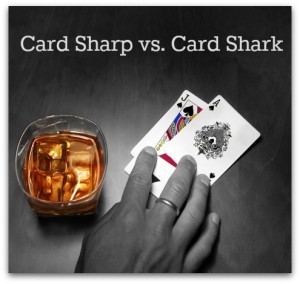 What would you call a person who is really good at playing card games? Probably a “card shark,” right? Of course you would—“shark” is a common term for somebody who succeeds thanks to a steely, hunter-like focus. Also, Card Sharks was a popular, cards-themed TV game show in the 1970s and ’80s.
What would you call a person who is really good at playing card games? Probably a “card shark,” right? Of course you would—“shark” is a common term for somebody who succeeds thanks to a steely, hunter-like focus. Also, Card Sharks was a popular, cards-themed TV game show in the 1970s and ’80s.
While card shark is now considered an acceptable term for a savvy cardsman, it’s only because of the evolution of language, derived from card sharp. Sometimes the language authorities (dictionary makers, and usually the people behind the Oxford English Dictionary) throw their hands up and make an inaccurate usage of a word “officially” acceptable because so many people do it. Examples of this phenomenon: How people use “literally” to describe something figurative, but with dramatic zest (“I was so embarrassed I literally died”) or how things that are just coincidences are deemed “ironic.”
“Card sharp” dates back to the 1880s, the time of Wild West saloons and card rooms, but had evolved into “card shark” by the 1940s, long before Card Sharks could have solidified the change. Oddly enough, both “card shark” and “card sharp” make sense in their usages. “Sharping” is a 19th century slang word that meant “swindling.” It was used in a variety of activities, not just gambling. For instance, a con man posing as a preacher in the Old West might be known as a “gospel sharp.” “Shark” in this regard comes from schurke, a German word that means “a cheater.” A “card sharp,” then, could very well also be a “card shark.”
(Another common English word is derived from schurke: shirk, which means to get out of, or cheat, one’s responsibilities.)
The post You’re Saying It Wrong! Card Sharp vs. Card Shark appeared first on Uncle Johns Bathroom Reader.



